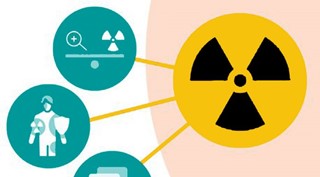Radiation Protection

Radiation Protection is the name given to work that ensures any exposure to ionising and non-ionising radiation is reduced as low as reasonably practicable. Ionising radiations can produce changes to living cells, and includes X-rays, Gamma rays and other types of radiation such as protons and neutrons used either in examinations to diagnose diseases, or as a treatment for cancer. Non-Ionising radiations including ultrasound, lasers, ultraviolet, microwaves, magnetic and radio frequency fields (MRI), can also be used for diagnosis or treatment.
Radiation protection has two main aims - to get the best diagnosis and give the correct therapy to patients while using the lowest possible level of radiation, and to protect all persons including the staff involved with the delivery of imaging and treatments.
How does radiation protection work?
Scientists working in radiation protection will check and calibrate equipment such as X-ray machines - including CT scanners, mammography units and other scanning and therapy equipment, to ensure that the level of radiation given to the patient is consistent with the level of diagnosis and treatment needed to improve their health.
All staff working with this equipment could also be exposed to various levels of radiation. So radiation protection scientists will determine

levels of shielding required and operational procedures including restrictions on time using the equipment and distance kept from the radiation, to reduce exposures below the acceptable levels as determined by regulations and guidance.
The environment could also be contaminated with radiation. Radiation protection scientists will calculate and monitor levels of disposal of radioactive materials through various waste streams and provide a radiological assessment, which will be checked by the relevant Government Agencies and Inspectors.
In addition, Clinical Scientists who are accredited Radiation Protection Advisers and Medical Physics Experts will give expert advice to the National Health Service and private organisations and liaise with government inspectors from the Health and Safety Executive, Environment Agency, Medicines Inspectors and others, to improve radiation protection of the general public. They also work with international organisations such as the International Commission on Radiological Protection, World Health Organisation and other bodies to improve radiation protection in all nations and the environment.
Future developments
Clinical Scientists working in radiation protection are continuously involved with research and the development of new techniques and treatment protocols. They discuss with clinicians ways to improve treatment and the best outcome for patients.